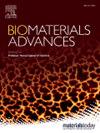Alginate-based hydrogels for sustained antimicrobial peptide delivery to enhance wound healing in diabetes
IF 5.5
2区 医学
Q2 MATERIALS SCIENCE, BIOMATERIALS
Materials Science & Engineering C-Materials for Biological Applications
Pub Date : 2025-05-06
DOI:10.1016/j.bioadv.2025.214337
引用次数: 0
Abstract
Diabetic foot ulcers (DFUs) are the leading cause of non-traumatic amputations, and its efficient management remains a clinical challenge, particularly in treating severe infections. Current treatment strategies often fail to address the multifactorial nature of DFUs. Combining antimicrobial peptides (AMPs) with the intrinsic properties of alginate hydrogels offers a promising solution for handling the complex etiology of DFUs. In this study, we designed alginate-based hydrogels for delivery of AMPs, namely the AMPs human β-defensin 2 (hBD-2) and PP4-3.1, to enhance diabetic wound healing. The hydrogels exhibited high storage modulus, low swelling ratio, and a nanometric porous structure, enabling sustained AMP release for over three days. Rheology analyses further confirmed their stability across pH 6 to 8. In vitro, hBD-2 hydrogels displayed excellent biocompatibility and promoted better cell migration than PP4-3.1 hydrogels, for up to 48 h. Thus, hBD-2 hydrogels were used in a streptozotocin-induced diabetic mouse model of wound healing. The hBD-2 hydrogels significantly accelerated wound closure and improved wound maturation, enhancing re-epithelialization and tissue remodeling, compared to controls. Furthermore, hBD-2 hydrogels reduced the microbial load from the wounds and attenuated inflammation at the wound site by decreasing the number of M1-like macrophages, M1/M2 ratio, and CD3+ cells. Lastly, a pro-reparative environment was promoted through a decrease in reactive oxygen species (ROS) levels, and an increase in neovascularization and collagen deposition. Altogether, these findings suggest that hBD-2 alginate hydrogels hold promise as a novel therapeutic option for managing DFUs, offering a combined anti-inflammatory, ROS-scavenging and tissue-regenerative effect.

海藻酸盐为基础的水凝胶持续抗菌肽递送促进伤口愈合糖尿病
糖尿病足溃疡(DFUs)是非创伤性截肢的主要原因,其有效管理仍然是临床挑战,特别是在治疗严重感染方面。目前的治疗策略往往不能解决dfu的多因素性质。将抗菌肽(AMPs)与海藻酸盐水凝胶的固有特性相结合,为处理DFUs的复杂病因提供了一种有前途的解决方案。在本研究中,我们设计了海藻酸盐为基础的水凝胶,用于递送AMPs,即AMPs人β-防御素2 (hBD-2)和PP4-3.1,以促进糖尿病伤口愈合。水凝胶具有高储存模量、低膨胀比和纳米级多孔结构,能够持续释放AMP超过三天。流变学分析进一步证实了它们在pH 6至8范围内的稳定性。在体外,hBD-2水凝胶表现出良好的生物相容性,并且比PP4-3.1水凝胶促进了长达48小时的细胞迁移。因此,hBD-2水凝胶被用于链脲霉素诱导的糖尿病小鼠伤口愈合模型。与对照组相比,hBD-2水凝胶显著加速了伤口愈合,改善了伤口成熟,增强了再上皮化和组织重塑。此外,hBD-2水凝胶通过减少M1样巨噬细胞的数量、M1/M2比率和CD3+细胞,减少了伤口的微生物负荷,减轻了伤口部位的炎症。最后,促修复环境是通过活性氧(ROS)水平的降低、新生血管和胶原沉积的增加来促进的。总之,这些发现表明,hBD-2海藻酸盐水凝胶有望成为治疗DFUs的一种新的治疗选择,具有抗炎、清除ros和组织再生的综合作用。
本文章由计算机程序翻译,如有差异,请以英文原文为准。
求助全文
约1分钟内获得全文
求助全文
来源期刊
CiteScore
17.80
自引率
0.00%
发文量
501
审稿时长
27 days
期刊介绍:
Biomaterials Advances, previously known as Materials Science and Engineering: C-Materials for Biological Applications (P-ISSN: 0928-4931, E-ISSN: 1873-0191). Includes topics at the interface of the biomedical sciences and materials engineering. These topics include:
• Bioinspired and biomimetic materials for medical applications
• Materials of biological origin for medical applications
• Materials for "active" medical applications
• Self-assembling and self-healing materials for medical applications
• "Smart" (i.e., stimulus-response) materials for medical applications
• Ceramic, metallic, polymeric, and composite materials for medical applications
• Materials for in vivo sensing
• Materials for in vivo imaging
• Materials for delivery of pharmacologic agents and vaccines
• Novel approaches for characterizing and modeling materials for medical applications
Manuscripts on biological topics without a materials science component, or manuscripts on materials science without biological applications, will not be considered for publication in Materials Science and Engineering C. New submissions are first assessed for language, scope and originality (plagiarism check) and can be desk rejected before review if they need English language improvements, are out of scope or present excessive duplication with published sources.
Biomaterials Advances sits within Elsevier''s biomaterials science portfolio alongside Biomaterials, Materials Today Bio and Biomaterials and Biosystems. As part of the broader Materials Today family, Biomaterials Advances offers authors rigorous peer review, rapid decisions, and high visibility. We look forward to receiving your submissions!

 求助内容:
求助内容: 应助结果提醒方式:
应助结果提醒方式:


